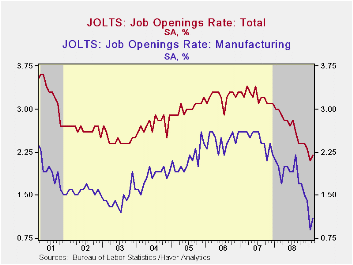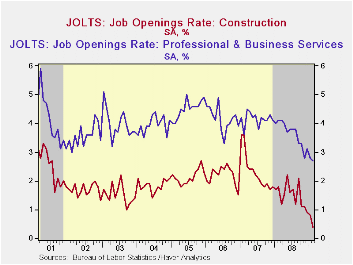 Global| Apr 07 2009
Global| Apr 07 2009JOLTS: U.S. Job Openings Tick Higher In February But Remain Off By One-Third Y/Y
by:Tom Moeller
|in:Economy in Brief
Summary
For February, the Bureau of Labor Statistics reported in its Job Openings & Labor Turnover Survey (JOLTS) that job availability made up just a piece of the January decline. The 2.9% rise in the number of job opening followed a 9.4% [...]

For February, the Bureau of Labor Statistics reported in its Job Openings & Labor Turnover Survey (JOLTS) that job availability made up just a piece of the January decline. The 2.9% rise in the number of job opening followed a 9.4% January falloff and openings remained off by roughly one-third from the year ago level. The latest level remained near the record low for the series which dates back to December 2000.
The job openings rate also rose modestly in February to 2.2% versus a downwardly revised 2.1% rate in January. These rates were down from more than a 3% rate in 2007. The job openings rate is the number of job openings on the last business day of the month as a percent of total employment plus job openings.
The actual number of job openings in the construction sector fell by 81% from the year ago level and factory sector job openings fell 50%, as did leisure & hospitality jobs which also were off by 50%. Professional & business services job openings fell more than one-third year-to-year while openings in the education & health sectors also were off by nearly one quarter. Openings in retail trade fell a slight 6% y/y. Not only were private sector openings down but government sector job openings fell a sharp 12% with state & local off 17% as tax revenues fell.
By region, openings in the West fell the hardest, by 42% year-to-year, while openings in the South and the Midwest were off roughly 30%. Openings in the Northeast they were down by a more moderate 12%.
The hires rate held steady for the third month at 3.3% and that was near the lowest in the series' short eight year history.The hires rate is the number of hires during the month divided by employment.The actual number of hires fell by 13% year-to-year with the largest declines coming in the leisure & hospitality industry (-25%) followed by the factory sector (-23%) and the retail sector (-22%). In the professional & business services industry the decline was a more moderate 11% while education & health services jobs fell 8%. Construction sector hires fell 2%.
The job separations rate fell slightly to 3.6%, about where it's been since early 2008. Separations include quits, layoffs, discharges, and other separations as well as retirements. The level of job separations fell 3.5% y/y.
The JOLTS survey dates only to December 2000 but has followed the movement in nonfarm payrolls, though the actual correlation between the two series is low.
A description of the Jolts survey and the latest release from the U.S. Department of Labor is available here and the figures are available in Haver's USECON database.
| JOLTS (Job Openings & Labor Turnover Survey) | February | January | February '08 | 2008 | 2007 | 2006 |
|---|---|---|---|---|---|---|
| Job Openings, Total | ||||||
| Rate (%) | 2.2 | 2.1 | 3.0 | 2.3 | 3.1 | 3.3 |
| Total (000s) | 3,006 | 2,920 | 4,248 | 3,224 | 4,382 | 4,606 |
| Hires, Total | ||||||
| Rate (%) | 3.3 | 3.3 | 3.7 | 41.1 | 46.1 | 47.6 |
| Total (000s) | 4,360 | 4,460 | 5,035 | 56,486 | 63,666 | 64,879 |
Tom Moeller
AuthorMore in Author Profile »Prior to joining Haver Analytics in 2000, Mr. Moeller worked as the Economist at Chancellor Capital Management from 1985 to 1999. There, he developed comprehensive economic forecasts and interpreted economic data for equity and fixed income portfolio managers. Also at Chancellor, Mr. Moeller worked as an equity analyst and was responsible for researching and rating companies in the economically sensitive automobile and housing industries for investment in Chancellor’s equity portfolio. Prior to joining Chancellor, Mr. Moeller was an Economist at Citibank from 1979 to 1984. He also analyzed pricing behavior in the metals industry for the Council on Wage and Price Stability in Washington, D.C. In 1999, Mr. Moeller received the award for most accurate forecast from the Forecasters' Club of New York. From 1990 to 1992 he was President of the New York Association for Business Economists. Mr. Moeller earned an M.B.A. in Finance from Fordham University, where he graduated in 1987. He holds a Bachelor of Arts in Economics from George Washington University.






